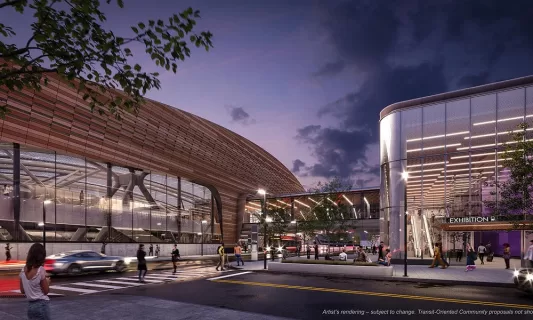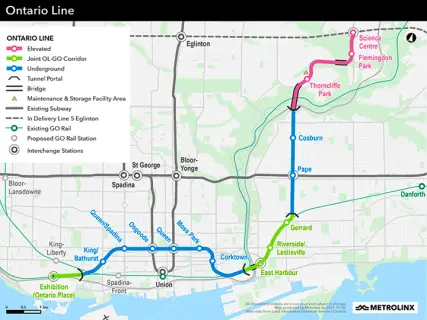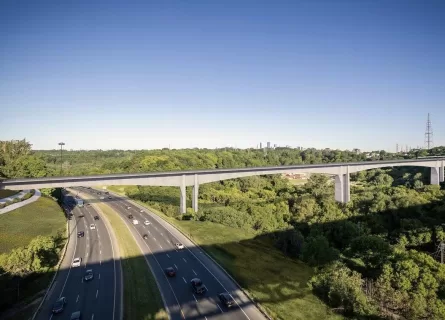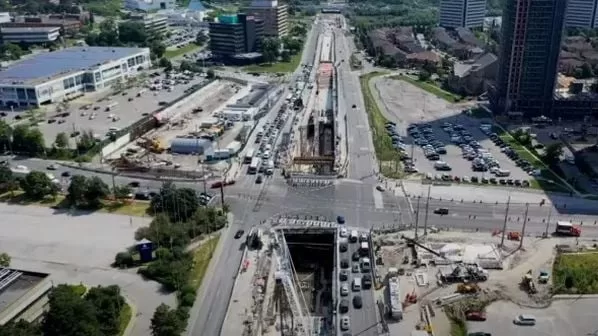Construction of the $27 billion Ontario line in Toronto, the first major subway, has made a significant milestone in its works. In over 60 years, the line began excavation of the launch shaft at the future Exhibition Station. This shows the commitment there has been since the project started to take shape. Since its groundbreaking in December 2021, work has gotten off to a quick start. As the three-year mark draws near, construction will begin on the six-kilometer tunnels. These tunnels will transport trains on the Ontario Line between Exhibition Station. Furthermore, they will also link to a portal located just west of the Don River.
The State of Affairs Regarding the Multi-billion-dollar Ontario Line
The construction progress on the Ontario line, one of the largest in Toronto has received commendable remarks. Preparations for the 16-meter-deep launch shaft have also been in progress. Moreover, tunnel-boring equipment will be dropped into the pit to start chiseling away eastward toward the Don when the shaft has been dug out. Once the shaft has fulfilled its original function, it will be converted into the future west entrance. It is expected that this is where trains heading to the Exhibition will emerge from the tunnels. In addition, the 15.5-kilometer Ontario Line will link to the GO network and the Eglinton Crosstown LRT. It will also link to Ontario’s Line 1, Line 2, and other higher-order transportation choices. The route, which will begin at Exhibition Place and travel through the center of downtown to the Eglinton Crosstown LRT at Don Mills Road, will add 15 new stations to the city.
Significance of the Massive Project in Ontario
The minister of Transportation Prabmeet Sarkaria praised the accomplishment. He noted that the construction of the Ontario line was a significant stride. One of the reasons he stated is that it has been “more than 60 years since the first subway tunnels were built in downtown Toronto.” The new launch shaft-turned-portal next to Exhibition Station is only one piece of the larger Ontario Line project. It is currently one of the biggest and priciest engineering undertakings in Canada with an estimated cost of more than $27 billion .An estimated 230,000 more Toronto people will be able to walk to public transportation thanks to the route.

Moreover, the project is anticipated to go into service by 2031. By building new transfer points at the intersection of the crowded Line 1 and Line 2 subways, it will also establish crucial links. This will lessen the strain on already-existing stations, such as the dangerously crowded Bloor-Yonge and St. George Stations. Officials also note that commuters would be able to cut their travel times by up to 40 minutes. They noted that “a trip across the city from Exhibition Place to the Eglinton Crosstown LRT at Don Mills Road will take 30 minutes or less compared to the hour and 10 minutes it takes. With a journey from one end to the other taking less than 30 minutes as opposed to the current transit duration of 70 minutes, it will allow people more time in the past. Furthermore, the project will help significantly alleviate congestion in the transit network.
Ontario Line Project Overview
The Ontario Line is a rapid transit line under construction in Toronto, Ontario, Canada. It is 15.6-kilometer long, starting from Exhibition Place, through the heart of downtown, and culminating at the Ontario Science Centre. The line’s northern terminus will be located at Eglinton Avenue and Don Mills Road, at Science Centre station, for its proper connection with Line 5 Eglinton. The southern terminus on the other hand will be developed at the existing Exhibition GO Station on the Lakeshore West line.

The Government of Ontario revealed plans for constructing the Ontario Line on the tenth of April 2019. At the time, its construction cost was estimated to be around $10.9 billion, and it was set to be completed by 2031. However, the cost of the project was revised in 2022 upwards to $27 billion and its completion in 2031.
The start of construction and scope of the Ontario Line project
A groundbreaking ceremony was held in March 2022 to officially mark the start of the construction of the Ontario Line in Toronto. Over half of the 15.6-kilometer line is set to run underground through new tunnels. The remainder will run along elevated and at-grade rail corridor sections. Fifteen stations are proposed, with numerous connections to the broader transit network. The network includes GO Transit rail services, the Toronto Transit Commission’s subway Lines 1 and 2, and the future Line 5 (Eglinton Crosstown LRT). Numerous bus and streetcar routes will also be part of it.
Once operational, the Ontario Line will make it faster and easier to travel within Toronto and beyond. It will also give people more time back in their days. A trip from one end to the other will take less than 30 minutes via the line compared to the 70 minutes it takes in transit. There will also be significant relief from crowding throughout the existing transit network thanks to the proposed connections. There are expected to be more than 40 other travel options along the way.
Also read:
City of Ontario launches Civic Centre Campus Expansion
Ontario Line in Toronto Project Timeline
Metrolinx prepared the Ontario Line plan in just three months based on transit consultant Michael Schabas’s proposal. In December 2018, Metrolinx hired Schabas to lead a team for the Relief Line plan’s transformation into the Ontario Line. Schabas advocated using lighter metro vehicles like the ones used in London’s Docklands Light Railway. He noted they are suitable for steeper grades and elevated structures. The drafted plan was ready by January 31, 2019, and Doug Ford approved it after a presentation on February 26. Moreover, Metrolinx kept the scheme a secret until April 10, when the government chose to reveal it.
2020:
The existing out-of-service passenger extended tunnel and station entrance was opened. The existing passenger tunnel was to be extended north. Moreover, the new north entrance was to be developed to offer continuous station access during the construction period. This will include future Ontario Line work. The new north platform was to service GO trains temporarily running on the shifted GO Track 1. After the construction of the Ontario Line station, the new north platform’s western portion would form a section of the joint GO-Ontario Line platform, removing the eastern portion. A temporary pedestrian bridge installation spanning the rail corridor which would provide more access capacity to arrive at station platforms and offer cross-corridor access for trips to Liberty Village and vice versa.
2021 May
The early works in Corktown Station included removing existing buildings and other structures, utility asphalt, decommissioning, soil removal, and other required remediation and early works scheme projects.
August 2021
On the existing rail bridge, a new bridge is being constructed on the Lower Don River that will have the Ontario Line tracks. GO tracks are being shifted in the nearby rail corridor and Don Yard to accommodate Ontario Line infrastructure. The existing rail bridge modifications allow GO track shifts and Ontario Line infrastructure.
December 2021
Metrolinx chose American engineering firm Bechtel as the delivery partner for its Ontario Line in Toronto. Bechtel, along with sub-vendors Bantrel and Comtech Group, will offer resources and expertise to support the construction of the 15.6km rapid transit route.

In mid-December, Toronto City Council approved a plan to close major roads, sidewalks, and bike lanes in the Downtown area. Starting in fall 2022 and ending in fall 2029, to prepare for the construction of the Ontario Line. This is especially true of the King-Bathurst, Queen-Spadina, Osgoode, Queen, and Corktown stations.
The road closures in the downtown area will affect frequently traveled Toronto throughways like Queen Street West. It will also affect Bathurst Street, King Street East, Spadina Avenue and Queen Street East. A complete shutdown of Queen Street between Bay and Victoria will begin in 2023 and last for four years.
January 2022
Preparatory work on the Ontario Line (OL) Queen Station is set to start this month. The utilities needing relocating at the Queen station site comprise the water main, underground telecom, sewer, hydro, and gas line system. Metrolinx will also be promoting the TTC installation of additional streetcar tracks on York Street to offer a detour for the TTC Queen 501 streetcar during the building of the Queen station.

Preferred Contractors Announced
Infrastructure Ontario and Metrolinx have revealed the preferred “proponent teams” for two contracts on the 15.6km Ontario Line. The project would connect the Ontario Exhibition Place station in downtown Toronto to the Ontario Science Centre station.
The Ontario Transit Group has been chosen for the design-build-finance contract for the civil, station, and tunnel work on the Ontario Line South. The new line’s 6.7km southern segment will necessitate the construction of 6km of tunnels. Thus, seven stations—six underground—will be constructed along the route. Work on this segment is anticipated to start next year and take seven years to finish.
“The Ontario Line South Civil contract will be Ferrovial Construction‘s largest contract to be executed and delivered worldwide,” said Ignacio Gastón, CEO of Ferrovial Construction. The fact that a project of this magnitude and scope is a part of our company’s portfolio says a lot about the knowledge and value we contribute to some of the world’s most complicated and visible infrastructure projects.
Read Also: Firms to jointly construct offshore wind projects in Latvia
The Ontario Line South project team
The chosen Connect 6ix team, led by Plenary Americas, Hitachi Rail, Webuild Group, and Transdev Canada, won the second contract, which covers the operations, maintenance, rolling stock, and systems for the Ontario Line. Thus, Infrastructure Ontario and Metrolinx will continue to negotiate contract terms with these teams. Furthermore, they anticipate awarding both contracts later this year.
The Ontario Line is being delivered through several contracts. These are which were obtained through conventional and public-private partnerships. Following will be enabling work for the bridge, railway, and other preliminary tasks. Also included are procurements for the major civil works in the north.
Portions of already-existing rail lines owned by Metrolinx will be used for the construction of the Ontario Line. This is in the western and eastern portions of the route. According to Metrolinx, it is reducing the quantity of tunnelling and excavation required. It is also reducing the complexity and duration of construction.

Leave a Reply